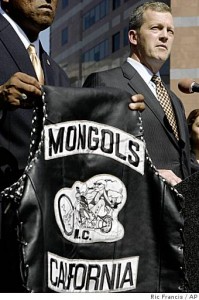So if you’ll allow me one moment of shameless patriotism, I’d like take a moment to declare that I am a proud American.
I’ve been thinking about this because of Joe The Plumber. Forget all the foolishness about his book deal or potential endorsement contracts or whether he’ll run for congress. There’s an argument, or an idea, that always hovers around Joe and his ilk — and his ilk’s intellectual defenders in the intellectual and pundit classes — that’s always puzzled me:
Why are these people so cynical about Americans?
Let me explain what I mean. Read more
Speaking of oil … I just read the phrase “drill, baby, drill” for the millionth time, and it finally occurred to me to stop and think from whence this pro-oil chant is derived.
That would be, if I’m not mistaken, “burn, baby, burn,” a phrase associated with the 1960s riots. According to BlogCritics Magazine (about which I actually know nothing, it’s just the first useful thing that Google took me to), a 1965 Newsweek article about the Watts riots included “one of the first” print references to that phrase. BlogCritics continues:
Made infamous by the riots, [the phrase] was first used by a disc jockey known as Magnificent Montague when he was working in New York and Chicago in ’63 and ’64. He’s shout it any time a piece of soul music got him excited, and he brought it with him to Los Angeles where his listeners appropriated it for the arson that marked the riots. During those terrible days, his station manager and even Mayor Yorty asked Magnificent Montague to give up his slogan. He did, at least while the fires were hot, changing to: “Have Mercy, Los Angeles!”
At first I thought, well, obviously the people chanting “Drill, baby, drill” don’t know or aren’t thinking about the phrase they are referencing.
But another possibility occurs to me. It’s obviously a fantasy that America’s much-discussed “dependence on foreign oil” is something that can be significantly changed by domestic drilling, no matter what deregulation occurs. But maybe the chanters know that — and are invoking the rioters of the 1960s intentionally.
That is, maybe they simply believe in the power of destructive spectacle: If we burn it all down or in this case drill it all to nothing, then somehow, from the ashes, from the ruins, a productive revolution of some kind emerges at some unspecified time in the future. Or if it doesn’t, at least some kind of pent-up emotion, or rage, has been released and spent. And when that catharsis is complete, we can sift through wreckage and the ashes and the spent remains, and start over.
If so, I can only say quote the Magnificent Montague: “Have mercy.”
“Driving on Interstate 44 from Springfield to St. Louis Missouri is pretty boring. But then you pass by this amazing building with the most fascinating type ever and it just makes your day.”
onpaperwings has some great sets, like this one of vernacular typography Polaroids, and this one of hand dryers(!). Probably they were both on BoingBoing a year ago, but I don’t care. If you haven’t seen them, check them out. (And Tom H. if you’re out there take note of this guy.)
Some brief follow-up material about the price of oil, consumer behavior, and energy alternatives. (Earlier mention here.)
Steven Mufson of the Washington Post wrote about the issue on October 20, and more recently talked it over with public radio show Word of Mouth.
And, on Marketplace yesterday:
Already, U.S. pickup demand is back on the rise, after collapsing earlier this year. Their sales share is nearly what it was before oil prices hit their high-end tipping point. [GM research executive Tom] Kloza says, so much for the buyers being changed forever.
Similar themes all around: The fear that weak oil prices, leading to cheap gas, can end up meaning that innovation-searching slows down, because consumer demand (and thus the profit motive) aren’t sufficient.
I wouldn’t say we’ve actually hit that point. Actually in some ways the number of stories on this proves we aren’t.
But what I want to add here is that I kind of think this GM guy gets off the hook a little too easily: If GM believes it’s important to sell smaller vehicles with better mileage, then make them and sell them. It’s disappointing if it’s true that consumer behavior change on this is so easily susceptible to backsliding, but whatever. Toyota didn’t need $100-a-barrel oil to develop the Prius.
Maybe this is old news, but I didn’t know until Charles told me:
Fred Radkte, the “Gray Ghost,” the guy in New Orleans who rollers over and obliterates any and all graffiti/street art, and has even been tweaked by Banksy, got arrested.
Apparently he painted over a mural that had every right to be there. Doug MacCash in Times Picayune:
On Wednesday, Radtke, New Orleans’ most celebrated and scorned anti-graffiti activist, was in the process of rolling gray enamel over a newly finished painting when he was brought up short by a pair of National Guard Military Police officers. Though Radtke has long enjoyed the cooperation of the New Orleans Police Department, this time he had defaced art that was painted with the permission of the wall’s owner, Southern Coating and Waterproofing.
Apparently there was no comment from Radtke. But now he has something more in common with his nemeses: Like them, he’s obsessed with leaving his mark all over town, and like them, he’s been hounded by The Man! “If convicted, he could be fined up to $500 and/or spend up to 90 days in jail, plus pay restitution.”
Meanwhile the mural he went up over has been redone. Pix here.
Posted Under:
Anti,
Artists
This post was written by Rob Walker on October 30, 2008
Comments Off on New Orleans top bomber: Busted!
… for best 2008 presidential election-inspired video on YouTube, is here. It’s only 2 and a half minutes, but it’s pretty great. It’s got my support.
We watched about one minute of the half-hour Obamamercial last night. It looked kind of boring, and as it happens we’ve already voted, so that was enough. In listening to and reading the rave reviews later, I was interested to hear that the total cost was, as I understand it, somewhere around $4 million or $5 million, for both production and air time on multiple networks.
I know everybody says that’s a lot of money, and for a political campaign it is. But in the larger scheme of corporate advertising, it really isn’t. Thirty seconds during the Super Bowl is more than $2 million, not counting production. More to the point, for a company like Nike, or Wal-Mart, $4 million isn’t much. Or how about Exxon Mobile: They just posted $14.8 billion in profits — for the quarter. When you’re looking at numbers like that, a few million bucks is peanuts.
I’m not arguing that, say, some oil company should take a half hour of slick propaganda time on a network near you. I’m just idly curious why it doen’t happen.
I’ve seen a few folks criticizing the redesign of the Pepsi logo, and I tend to agree: I don’t see the point, and I don’t care for the result. But PSFK has a nice image of a bunch of Pepsi cans showing the brand’s visual changes over the years, and it’s pretty cool:

The type-only versions are pretty cool, especially the very first one. But I really like the concept of putting an image of a bottle cap on the side of a can. Who thought of that? Kind of amusing. And I think the first of those two, with the elaborate and exciting type treatment, I think that’s my favorite.
See the PSFK post to view the rather bloodless new logo.
Bonus: Old Murketing post on “Be A Pepsi Punk” T-shirt in The Great Rock N Roll Swindle.
Funny story in the NYT today about a guy who has won 11 “user-generated ad” contests, “earning more than $200,000 in money and prizes.” A great example of the co-promotion theory of what inspires amateurs to make ads: It’s not about hyping the brand, it’s about hyping the maker.
Mr. Levinson has a Facebook group entitled “Yes, Joel, I’ll vote for your newest stupid contest” and he uses Twitter, blogs, e-mail and text messages, asking acquaintances to vote. He even calls 24-hour customer service lines at night, when he thinks the representatives are bored, and asks them to vote for him.
The other day I was reading some random news story on a newspaper site — I think a Philadelphia paper, and the article was something about the McCain campaign.
At the bottom was this:

I’m interested in the stuff at right. People who read this article also bought a Movado watch? Or a portable DVD player? Really? How many people? And how is that useful information?
I’m more than a week late in pointing out Roger Lowenstein’s interesting article for the Times Mag about oil and oil prices, but if you’re interested in the subject, I recommend it. In addition to explaining oil-price fluctuations more clearly than I’ve seen anybody else do it, he has some great forward-looking points.
Back when oil prices were first soaring past $125 a barrel and George Soros was blaming speculators, I started to write a post here saying I hope he’s wrong because the high price (while it seemed illogically overdone to me) was clearly focusing attention on sustainable oil alternatives, etc. I never finished writing it because, ultimately, the post I conceived sort of depended on the idea that oil prices could seriously collapse, which just seemed so outlandish to me at the time I didn’t see the point.
Anyway, so here’s Lowenstein — a writer I have a ton of respect for, very smart and very lucid — making a more sophisticated version of that point. Instead of thinking about popular opinion as a lever on policymakers, as I was, he’s thinking private industry. Basically, there’s a relationship between the price of oil and the incentives for investing in alternatives to it: “When you ask economists what the minimum oil price is to sustain the development of alternatives to gasoline — new battery systems or sugar ethanol or even wood chips — you get a range of something like $75 a barrel to maybe $150.”
Lowenstein doesn’t come out totally against oil, what he’s making a point about is oil dependence, and in what it takes to inspire companies to make the necessary investments that could lead not just to new oil reserve discovers, but to completely new alternatives.
It would be a tragedy if falling prices were to extinguish such alternatives and — given the time lag inherent in energy development — leave the country vulnerable to a yet another round of shocks… .
What the country doesn’t want is to remain dependent only on oil — to lose the urgency to develop alternatives. It happened once before. After the gas lines of the ’70s, Jimmy Carter declared that solving our energy problems was the moral equivalent of war. Then, in the 1980s, Americans forgot.
He closes by suggesting (in a revival of a Gerald Ford idea) a tax that would kick in if oil fell below $70 a barrel — basically setting a floor.
Interestingly, when the piece was written, oil was at around $80 a barrel. Today it’s at around $63.
 TOP YELLER:
TOP YELLER:
The enduring appeal of the pitchman.
Today in Consumed, a look at the appeal of one of TV’s most ubiquitous sellers.
Much more interesting than the unlikely merchandise he booms on about is the boomer himself. With his slicked-back hair, beard and thunderclap voice, he begins most of his many two-minute spots by proclaiming: “Hi! Billy Mays here!” Usually declarations like this are reserved for those whose achievements or fame in some other corner of culture (movies, sports, reality television) are being leveraged on behalf of a product. Mays is a celebrity endorser whose celebrity is based entirely on having endorsed things.
Read the column in the October 26, 2008, issue of The New York Times Magazine, or here.
Bonus link: BillyMaysRules.com.
Consumed archive is here, and FAQ is here. The Times’ Consumed RSS feed is here. Consumed Facebook page is here.
To make a point about Consumed that you think readers of The Times Magazine would be interested in: “Letters should be addressed to Letters to the Editor, Magazine, The New York Times, 620 Eighth Avenue, 6th Floor, New York, N.Y. 10018. The e-mail address is magazine@nytimes.com. All letters should include the writer’s name, address and daytime telephone number. We are unable to acknowledge or return unpublished letters. Letters may be edited for length and clarity.”
Posted Under:
Advertising,
Consumed,
Entertainment
This post was written by Rob Walker on October 26, 2008
Comments Off on In The New York Times Magazine: Billy Mays
I don’t want make too much of this, but it’s interesting that as retail sales and consumer spending have fallen, and, you know, media coverage of the economy has basically devolved into one extended freakout, Etsy says its sales have continued to rise.
- $7.93 million of goods sold — a 5% increase over August.
- That represents 544,157 items sold, a 5.3% increase from August’s stats.
Interesting. Etsy’s not exactly positioned as a bargain-hunting site. Maybe all it means is that its in a growth phase, being still relatively small, that would be pronounced in a more optimistic economy. Or maybe it means that “handmade” stuff is holding onto value in consumer minds that more mass goods are not holding onto.
The latter theory reminds me of something I read the other day on the Greenjeans blog, which asked, “Is ‘handwashing’ the new greewashing?” Basically this refers to making stuff look handmade.
I wonder if I didn’t see a hint of the next big marketing trend today on the cover of the graphic design magazine HOW: “Incorporating Handmade Elements.” They actually call it “Design 2.0” suggesting the techie look is out and the handmade look is in.
Greenjeans’ Amy Shaw continues:
I think perhaps because handmade makes us feel safe, and makes huge corporations seem kinder and gentler. And in today’s struggling economy, those companies that can make consumers feel warm and fuzzy will have a huge advantage.
Maybe this helps explain Etsy resilience? If so, then perhaps there’s more “handwashing” to come. . .
 The Mongols Motorcycle Club, or Mongols MC, is based in southern California. It has an estimated 1,000 members, and it has a logo.
The Mongols Motorcycle Club, or Mongols MC, is based in southern California. It has an estimated 1,000 members, and it has a logo.
A trademarked logo.
According to the U.S. government, it’s also a criminal organization, engaged in everything from drug trafficking to murder; 79 members were named in a recent racketeering indictment.
Yesterday, the government also had a bit of success in a different avenue it is pursuing vis a vis the Mongols MC:
U.S. District Court Judge Florence-Marie Cooper on Wednesday granted an injunction that prohibits gang members, their family members and associates from wearing, licensing, selling or distributing the logo, which typically depicts the profile of a Mongolian warrior wearing sunglasses.
According to the AP, this is “believed to be the first case in the nation in which the government has sought to take control of a gang’s identity — via its logo — through a court order.”
The upshot, as I understand it from the story, is that anything with a Mongols MC logo on it is now subject to seizure. I gather that the “club” or “gang” or whatever it is did in fact go through the legal steps to trademark its logo. But now that logo is, in effect, illegal.
UPDATE: I see now that Counterfeit Chic had a similar item two days ago, and has more, here. Cites an L.A. Times article explaining that the plan involves “the government [taking] over ownership of the trademark,” which would allow the seizures. I wonder if it would also allow them to cut some licensing deals!
[Thx: Harold C.]




 "
"




 TOP YELLER:
TOP YELLER:












 Kim Fellner's book
Kim Fellner's book  A
A